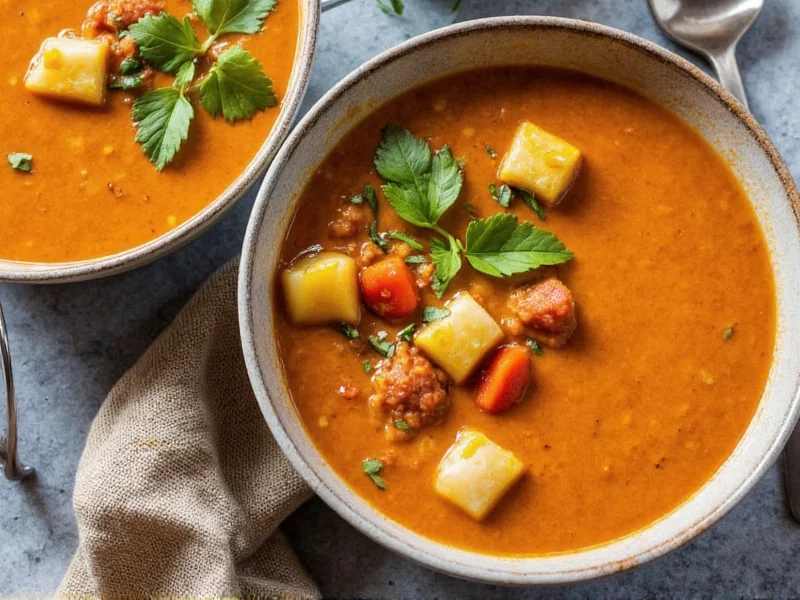Creating satisfying vegan soups requires understanding flavor foundations and nutritional balance. Unlike traditional soups that rely on meat stocks or dairy, vegan versions use vegetable broths, mushrooms, seaweed, and umami-rich ingredients to build depth. The best vegan soups deliver robust flavor while providing complete protein through strategic ingredient combinations like beans with grains.
The Nutritional Power of Plant-Based Soups
Vegan soups transform simple ingredients into nutrient-dense meals. When crafted with intention, they contain all nine essential amino acids, complex carbohydrates, healthy fats, and phytonutrients. A well-designed vegan soup typically delivers 15-25 grams of protein per serving when incorporating legumes, tofu, or quinoa. The high fiber content from vegetables and whole grains promotes digestive health and creates lasting satiety.
| Key Nutrient | Primary Vegan Sources | Health Benefit |
|---|---|---|
| Complete Protein | Lentils + rice, chickpeas + barley | Muscle maintenance, enzyme production |
| Omega-3 Fatty Acids | Flax seeds, walnuts, algae oil | Heart and brain health |
| Vitamin B12 | Fortified nutritional yeast, plant milks | Nervous system function |
| Iron | Spinach, lentils, tofu with vitamin C | Blood health, energy metabolism |
Building Blocks for Flavorful Vegan Soups
Master vegan soup preparation by developing your mirepoix technique with plant-based alternatives. Traditional mirepoix (onion, celery, carrot) forms an excellent base, but expand your flavor profile with:
- Umami boosters: Dried mushrooms, tomato paste, miso paste, soy sauce, nutritional yeast
- Creaminess without dairy: Blended cashews, coconut milk, potatoes, white beans
- Aromatic foundations: Garlic, ginger, lemongrass, smoked paprika
- Acidity for balance: Lemon juice, apple cider vinegar, tamarind
Professional chefs recommend "layering" flavors by sautéing aromatics first, adding dry spices to toast, then deglazing with acidic components before introducing liquids. This technique creates complex flavor profiles that compensate for the absence of animal products.
Seasonal Vegan Soup Guide
Adapt your vegan soup recipes to seasonal produce for peak flavor and nutrition. Seasonal cooking reduces environmental impact while maximizing taste and nutrient density. Consider these seasonal pairings:
- Spring: Asparagus and pea soup with fresh herbs
- Summer: Chilled tomato gazpacho or corn chowder
- Fall: Roasted squash soup with sage and apple
- Winter: Hearty lentil and root vegetable stew
Local farmers markets provide the freshest ingredients for seasonal vegan soups. When produce isn't available locally, frozen vegetables often retain more nutrients than shipped fresh alternatives. This approach supports sustainable vegan soup preparation year-round.
Five Essential Vegan Soup Recipes
1. Classic Hearty Vegetable Soup
This versatile base works for any season. Sauté onions, carrots, and celery, then add vegetable broth, diced tomatoes, and seasonal vegetables. Include kidney beans for protein and barley for texture. Simmer until vegetables reach desired tenderness. Finish with fresh parsley and a splash of balsamic vinegar.
2. Creamy Roasted Cauliflower Soup
Roast cauliflower with garlic until caramelized, then blend with vegetable broth and a quarter-cup of raw cashews. The cashews create natural creaminess without dairy. Season with white pepper and fresh thyme. This easy vegan soup recipe delivers restaurant-quality results with minimal ingredients.
3. West African Peanut Stew
Combine tomato-based broth with sweet potatoes, chickpeas, and spinach. Stir in natural peanut butter for richness and depth. This nutritious plant-based soup provides complete protein and healthy fats. Serve over brown rice for a satisfying meal.
4. Miso Ginger Noodle Soup
Create a flavorful broth with kombu and shiitake mushrooms. Whisk in white miso paste off-heat to preserve probiotics. Add sliced ginger, tofu cubes, and buckwheat noodles. This quick vegan soup recipe works perfectly for weeknight dinners and supports digestive health.
5. Smoky Black Bean Soup
Sauté onions with smoked paprika and cumin, then add black beans, fire-roasted tomatoes, and vegetable broth. Simmer until flavors meld, then blend half the soup for creaminess. Top with avocado and cilantro. This protein-rich vegan soup delivers 18 grams of protein per serving.
Avoiding Common Vegan Soup Mistakes
Many beginners make these errors when preparing vegan soups:
- Underseasoning: Plant-based soups need more seasoning than meat-based versions. Taste and adjust at multiple stages.
- Over-reliance on salt: Build flavor with herbs, spices, acids, and umami sources instead of excessive sodium.
- Texture issues: Blend portions of bean or vegetable soups for creaminess without dairy.
- Protein neglect: Include legumes, quinoa, or tofu to ensure adequate protein content.
Professional chefs recommend finishing vegan soups with a "flavor bridge" - an element that connects all components. This might be a swirl of herb oil, a squeeze of citrus, or a sprinkle of toasted seeds. These finishing touches elevate homemade vegan soups from good to exceptional.
Storage and Reheating Best Practices
Vegan soups often improve with time as flavors meld. Store properly to maintain quality:
- Cool soups completely before refrigerating to prevent condensation
- Store in airtight containers for 4-5 days in the refrigerator
- Freeze in portion-sized containers for up to 3 months
- Add delicate ingredients like fresh herbs or greens when reheating
When reheating, do so gently over medium-low heat to preserve texture and nutrients. Stir occasionally and add small amounts of water or broth if the soup has thickened. Most seasonal vegan soup ideas maintain quality through multiple freeze-thaw cycles, making them ideal for meal prep.











 浙公网安备
33010002000092号
浙公网安备
33010002000092号 浙B2-20120091-4
浙B2-20120091-4